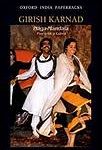Two best friends. One lady love. Talking dolls. Mute kid. Cursed horse-man in search of completeness. Goddess Kali. Elements of folk theatre – Nata – the actor, Bhagavata – the singer-storyteller, masks, stage hands holding curtains that illustrate the scene. Girish Karnad’s Hayavadana (I read the English translation) combines myth, folklore and man’s quest for completeness and identity in one entertaining play.
This is only the second play of Karnad’s I read, but the playwright’s penchant for folklore, myth (and history) shows up. Also using two parallel plots/ stories intertwined is a common device in both Nagamandala and Hayavadana. While Nagamandala adapted two of AK Ramanujan’s stories, Hayavadana draws from Kathasaritsagara and more specifically Thomas Mann’s adaptation – The Transposed Heads. ‘The original (story of King Vikram and the wandering spirit Vetal) poses a moral problem while Mann uses it to ridicule the mechanical conception of life which differentiates between body and soul. He ridicules the philosophy which holds the head superior to the body. The human body, Mann argues, is a fit instrument for the fulfillment of human destiny. Karnad’s play poses a different problem, that of human identity in a world tangled relationships… Neither the death of the lovers nor the subsequent sati of Padmini is presented as tragic; the deaths serve only to emphasize the logic behind the absurdity of the situation. The subplot of Hayavadana, the horse-man, deepens the significance of the main theme of incompleteness by treating it on a different plane. The horse-man’s search for completeness ends comically with his becoming a complete horse. The animal body triumphs over what is considered the best in man, the Uttamanga, the human head.’ – Kirtinath Kurtkoti in foreword to the play.
What struck me the most was the comic folk style presentation of a tragic story of incomplete humans in search of completeness. Of Padmini, Kapila and Devdutta but also of Hayavadana the half horse half man cursed. With songs and traditional props and an underlying caricaturish gaze, the play come across as a lively, upbeat and not grim even in its saddest scenes and most negative emotions stand as a matter of fact. Elements from Yakshagana and other traditional theatre forms add to this effect. As in Nagamandala, Karnad’s language is very visual and paints vivid picture through words. Take this, Padmini’s monologue in Act 2;
My poor child, you haven’t seen the witching fair of the dark forest, have you? There’s so much. Long before the sun rises, the shadows of twigs draw alpanas on the floor. The stars raise arati and go. Then the day dawns and the fun begins. The circus in the tree-tops and the cock-fights in a shower of feathers. And the dances! The tiger-dance and the peacock-dance and the dance of sun’s little feet with silver anklets on the river. In the heart of the forest stands the stately chariot of the shield-bearer. It’s made of pure gold – rows of birds pull it down the street, and rows of flames of the forest salute it with torches. Then the night comes, and our poor baby is tired – so we blow gently and out goes the moon. But before we leave there’s one more thing to do. Right outside the fair, watching it from a distance, stands the tree of the Fortunate Lady. It’s an old tree, a close friend of ours. We have to say ‘hello’ to it. All right?
We are of course, introduced to the Fortunate Lady before in a great scene of significance to the three characters.
Written in 1971, Hayavadana is Karnad’s 3rd play after Yayati (1961) and Tughlaq (1964)


